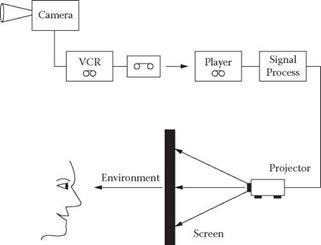Controlling daylight—using blinds or sun shading—must have a very high priority in any control room design. In applications where daylight cannot be controlled, consideration should be given to placing the display carefully to avoid high luminances, such as windows in the field of vision. Furthermore, direct light from the windows or the lighting onto the display should be avoided in any case, as this will affect the contrast and therefore the ‘viewability’.
4.4.6 Image Quality
The perceived quality of an image is the end result of a long chain of different components and factors (Figure 4.14).
A typical chain determining image quality might include: the quality of the signal source (such as the graphic adaptor in a PC or a video camera); all of the electronic components for signal processing, storing, switching, and so forth; all the cables in a system; the display device itself; and the ‘output’ from the display as ‘controlled light’ entering our perception system via the optic nerves in the eye. The display device itself is critical to image quality, combining factors such as resolution, sharpness, colour reproduction, uniformity, contrast ratio, pixilation (in the case of
|
FIGURE 4.14 Chain of components affecting perceived image quality. |
pixel-based display devices, such as liquid crystal display (LCD) projectors, line structure (in the case of CRT-based display devices), and dynamics (coping with moving images).




